By Robert St. Martin
 Los Angeles, CA (The Hollywood Times) 3/29/23 – Fresh out of Sundance 2023, Lisa Cortes’ documentary Little Richard: I Am Everything (2022) screened on Tuesday evening at the at the Tateuchi Democracy Forum Theatre of the Japanese American National Museum (JANM) in Little Tokyo in Los Angeles. It has been included in this year’s line-up of films at the Outfest Fusion Film Festival 2023. Director Lisa Cortés’ documentary Little Richard is in some ways a conventional documentary about a rock legend, combining archival footage with talking head interviews from experts and generous helpings of the man’s music itself. As a film made to get people to talk more about Little Richard in the scope of rock ‘n’ roll, the film prevails. At its best, Little Richard: I Am Everything best fosters a general understanding of his music and makes you want to dig deeper into his art. “The film from Bungalow Media + Entertainment, CNN Films, HBO Max, and Rolling Stone Films was acquired by Magnolia Pictures, out of Sundance, and will be released on April 21 in theaters and on demand. At this special screening, there was a video-taped introduction by director of Lisa Cortes addressed to the Outfest Fusion audience.
Los Angeles, CA (The Hollywood Times) 3/29/23 – Fresh out of Sundance 2023, Lisa Cortes’ documentary Little Richard: I Am Everything (2022) screened on Tuesday evening at the at the Tateuchi Democracy Forum Theatre of the Japanese American National Museum (JANM) in Little Tokyo in Los Angeles. It has been included in this year’s line-up of films at the Outfest Fusion Film Festival 2023. Director Lisa Cortés’ documentary Little Richard is in some ways a conventional documentary about a rock legend, combining archival footage with talking head interviews from experts and generous helpings of the man’s music itself. As a film made to get people to talk more about Little Richard in the scope of rock ‘n’ roll, the film prevails. At its best, Little Richard: I Am Everything best fosters a general understanding of his music and makes you want to dig deeper into his art. “The film from Bungalow Media + Entertainment, CNN Films, HBO Max, and Rolling Stone Films was acquired by Magnolia Pictures, out of Sundance, and will be released on April 21 in theaters and on demand. At this special screening, there was a video-taped introduction by director of Lisa Cortes addressed to the Outfest Fusion audience.
 Little Richard was a complicated man with a complicated life story. Ultimately, the film focuses on two threads, both of which are equally fascinating. One is that Little Richard was a pioneering queer artist in both his music and on-stage presentation, bringing all of that to a time and place (the 1950s South) that one would think wouldn’t be ready for that. Even then, he had a highly complex relationship with his sexuality, even claiming to renounce homosexuality at various times throughout his life. At one point, at the height of his fame, even renounced rock ‘n’ roll as well, in favor of religion and studying in a Seventh Day Adventist seminary, producing a Gospel album and marrying a woman he met in the seminary.
Little Richard was a complicated man with a complicated life story. Ultimately, the film focuses on two threads, both of which are equally fascinating. One is that Little Richard was a pioneering queer artist in both his music and on-stage presentation, bringing all of that to a time and place (the 1950s South) that one would think wouldn’t be ready for that. Even then, he had a highly complex relationship with his sexuality, even claiming to renounce homosexuality at various times throughout his life. At one point, at the height of his fame, even renounced rock ‘n’ roll as well, in favor of religion and studying in a Seventh Day Adventist seminary, producing a Gospel album and marrying a woman he met in the seminary.
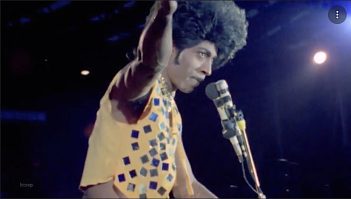 Several music historians and academicians attempt to explain how “queerness” worked for Little Richard, although the film does not pursue this topic in any depth. One historian explains that “queer” is anything non-normative and most certainly the music of Little Richard was non-normative when he first began to create his songs and perform them in segregated 1950s America. So much black music came from the South and it was only when white teenagers started listening to it on black radio stations in the 1950s that rock ‘n roll was really born. He burst on the music scene with a unique hyper-energetic performance style in terms of vocals and playing the piano. His singular style at the piano was, more or less, boogie woogie with the left hand and a locomotive percussive style with the right hand that he picked up from Ike Turner.
Several music historians and academicians attempt to explain how “queerness” worked for Little Richard, although the film does not pursue this topic in any depth. One historian explains that “queer” is anything non-normative and most certainly the music of Little Richard was non-normative when he first began to create his songs and perform them in segregated 1950s America. So much black music came from the South and it was only when white teenagers started listening to it on black radio stations in the 1950s that rock ‘n roll was really born. He burst on the music scene with a unique hyper-energetic performance style in terms of vocals and playing the piano. His singular style at the piano was, more or less, boogie woogie with the left hand and a locomotive percussive style with the right hand that he picked up from Ike Turner.
 The other major theme in this film is that Little Richard, despite his status as one of the most important and influential figures in rock history, felt consistently under-appreciated throughout his life. He wrote classic songs starting in the 1950s, which were usually covered by white artists like Elvis Presley and Pat Boone who profited much more handsomely than he did. The film uses that to tell a wider story about how the history of rock music has been whitewashed, with little acknowledgment of the Black pioneers of the genre. He combined rock vocals and instrumentation with flamboyant stage antics and heavy makeup, decades before Freddie Mercury, David Bowie, or Elton John would earn millions doing the same.
The other major theme in this film is that Little Richard, despite his status as one of the most important and influential figures in rock history, felt consistently under-appreciated throughout his life. He wrote classic songs starting in the 1950s, which were usually covered by white artists like Elvis Presley and Pat Boone who profited much more handsomely than he did. The film uses that to tell a wider story about how the history of rock music has been whitewashed, with little acknowledgment of the Black pioneers of the genre. He combined rock vocals and instrumentation with flamboyant stage antics and heavy makeup, decades before Freddie Mercury, David Bowie, or Elton John would earn millions doing the same.
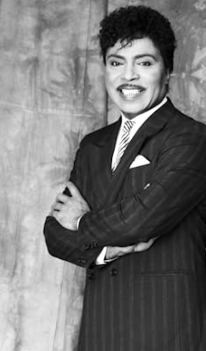 The man born Richard Wayne Penniman truly did live an amazing, only-in-America life. Born in 1932, he was a Southern Black man from a large family in Macon, Georgia. He emerged in his early 20s with a series of hits that included “Tutti Frutti,” “Long Tall Sally,” and “Good Golly Miss Molly.” Speaking of “Tutti Frutti,” the film provides a most interesting explanation of what the original lyrics were of his signature song. If you know, you know, and if you don’t, here they are: “Tutti Frutti, good booty / If it don’t fit, don’t force it / You can grease it, make it easy.” By today’s standards in hip-hop, this is not shocking, but in the 1950s, it is no wonder that the record producers decided to change the lyrics something less sexually explicit: “Tutti frutti, oh rootie / A wop bop a loo bop a lop bom bom.”
The man born Richard Wayne Penniman truly did live an amazing, only-in-America life. Born in 1932, he was a Southern Black man from a large family in Macon, Georgia. He emerged in his early 20s with a series of hits that included “Tutti Frutti,” “Long Tall Sally,” and “Good Golly Miss Molly.” Speaking of “Tutti Frutti,” the film provides a most interesting explanation of what the original lyrics were of his signature song. If you know, you know, and if you don’t, here they are: “Tutti Frutti, good booty / If it don’t fit, don’t force it / You can grease it, make it easy.” By today’s standards in hip-hop, this is not shocking, but in the 1950s, it is no wonder that the record producers decided to change the lyrics something less sexually explicit: “Tutti frutti, oh rootie / A wop bop a loo bop a lop bom bom.”
 We get insights, in the film, from everyone from Mick Jagger and Paul McCartney to a series of academic commentators and music historians, as well as surviving band members. The Beatles saw Little Richard in Liverpool and followed him to Hamburg where McCartney concedes that he borrowed Little Richard’s vocal wailing in “Twist and Shout” as a break from boring British pop music style. Mick Jagger says that he went to see Little Richard perform 30 times and admired the way that Little Richard moved around on the whole stage and even jumped on top of the piano – something Elton John would later do as well. Pancake make-up and looking pretty appealed to the young white teenage crowd who made black rock ‘n roll acceptable to them. Little Richard’s brash queerness made him “non-threatening” to white audiences. “His DNA was everywhere,” one of the doc’s many talking heads says.
We get insights, in the film, from everyone from Mick Jagger and Paul McCartney to a series of academic commentators and music historians, as well as surviving band members. The Beatles saw Little Richard in Liverpool and followed him to Hamburg where McCartney concedes that he borrowed Little Richard’s vocal wailing in “Twist and Shout” as a break from boring British pop music style. Mick Jagger says that he went to see Little Richard perform 30 times and admired the way that Little Richard moved around on the whole stage and even jumped on top of the piano – something Elton John would later do as well. Pancake make-up and looking pretty appealed to the young white teenage crowd who made black rock ‘n roll acceptable to them. Little Richard’s brash queerness made him “non-threatening” to white audiences. “His DNA was everywhere,” one of the doc’s many talking heads says.
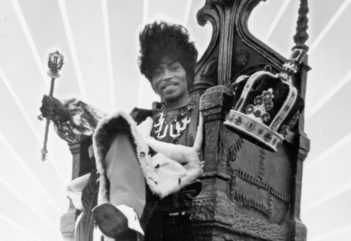 John Waters, who admits that the pencil mustache that’s been part of his look for decades was a direct homage to Little Richard, is the film’s best participant. He talks about how when he was growing up in Baltimore, all the white kids loved the Black radio stations, something that would inspire him to make the many different versions of Hairspray. Billy Porter also is there to show how Little Richard, in many ways, made what he does possible and how flamboyant dress on stage is more than just being “queer.”
John Waters, who admits that the pencil mustache that’s been part of his look for decades was a direct homage to Little Richard, is the film’s best participant. He talks about how when he was growing up in Baltimore, all the white kids loved the Black radio stations, something that would inspire him to make the many different versions of Hairspray. Billy Porter also is there to show how Little Richard, in many ways, made what he does possible and how flamboyant dress on stage is more than just being “queer.”
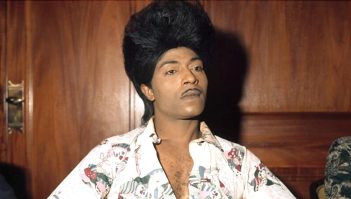 The film follows the many twists and turns of Little Richard’s life, which included the time he gave up secular music just a few years into his biggest success, turning to gospel music instead. He was back in the pop/rock fold by the mid-’60s, where he’s said to have influenced numerous other luminaries. Little Richard had a long life and passed away in 2020 at the age of 87. The film, presumably conceived and made after the singer’s death, does a great job collecting the archival footage, although the talking heads are more of a mixed bag. Little Richard was a complex individual and not a reliable narrator of his own story. In numerous television interviews, his self-confidence and charisma come across loudly, including his signature expression “Shut Up” which is still popular today.
The film follows the many twists and turns of Little Richard’s life, which included the time he gave up secular music just a few years into his biggest success, turning to gospel music instead. He was back in the pop/rock fold by the mid-’60s, where he’s said to have influenced numerous other luminaries. Little Richard had a long life and passed away in 2020 at the age of 87. The film, presumably conceived and made after the singer’s death, does a great job collecting the archival footage, although the talking heads are more of a mixed bag. Little Richard was a complex individual and not a reliable narrator of his own story. In numerous television interviews, his self-confidence and charisma come across loudly, including his signature expression “Shut Up” which is still popular today.
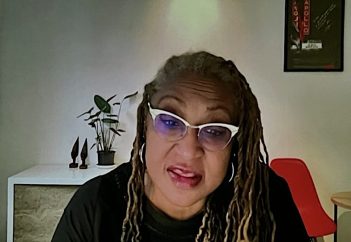 While the documentary effectively praises Little Richard’s impact, it doesn’t go too deep. In particular, Little Richard: I Am Everything doesn’t delve very much into his queerness or later religious fervor, and how he made those parts work within his overall mission of being himself. I suggest you see the documentary film of Lisa Cortes and learn more about the true father of rock ‘n roll.
While the documentary effectively praises Little Richard’s impact, it doesn’t go too deep. In particular, Little Richard: I Am Everything doesn’t delve very much into his queerness or later religious fervor, and how he made those parts work within his overall mission of being himself. I suggest you see the documentary film of Lisa Cortes and learn more about the true father of rock ‘n roll.